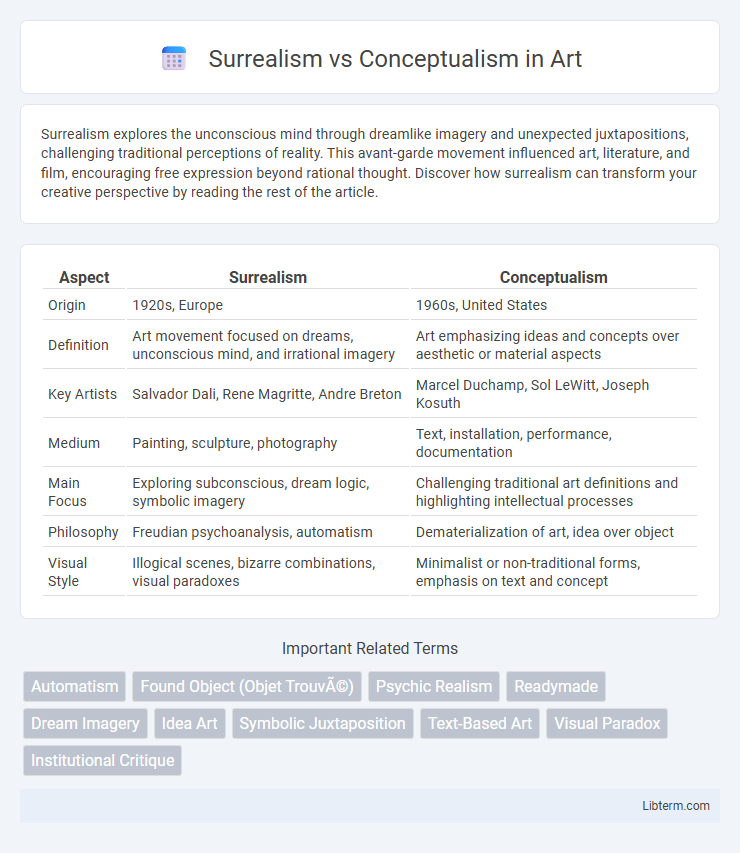Surrealism explores the unconscious mind through dreamlike imagery and unexpected juxtapositions, challenging traditional perceptions of reality. This avant-garde movement influenced art, literature, and film, encouraging free expression beyond rational thought. Discover how surrealism can transform your creative perspective by reading the rest of the article.
Table of Comparison
| Aspect | Surrealism | Conceptualism |
|---|---|---|
| Origin | 1920s, Europe | 1960s, United States |
| Definition | Art movement focused on dreams, unconscious mind, and irrational imagery | Art emphasizing ideas and concepts over aesthetic or material aspects |
| Key Artists | Salvador Dali, Rene Magritte, Andre Breton | Marcel Duchamp, Sol LeWitt, Joseph Kosuth |
| Medium | Painting, sculpture, photography | Text, installation, performance, documentation |
| Main Focus | Exploring subconscious, dream logic, symbolic imagery | Challenging traditional art definitions and highlighting intellectual processes |
| Philosophy | Freudian psychoanalysis, automatism | Dematerialization of art, idea over object |
| Visual Style | Illogical scenes, bizarre combinations, visual paradoxes | Minimalist or non-traditional forms, emphasis on text and concept |
Introduction to Surrealism and Conceptualism
Surrealism emerged in the early 20th century as an artistic movement emphasizing dreamlike imagery and the exploration of the unconscious mind through symbolic and fantastical visuals. Conceptualism, gaining prominence in the 1960s, prioritizes the idea or concept behind the artwork over traditional aesthetic and material concerns, often using text and performance to challenge conventional art forms. Both movements revolutionized modern art, with Surrealism focusing on emotional and psychological depth, while Conceptualism redefined art as intellectual inquiry.
Historical Origins and Evolution
Surrealism, emerging in the early 1920s from the Dada movement and influenced by Sigmund Freud's psychoanalysis, sought to unlock the unconscious mind and explore dreamlike imagery through automatic writing and visual arts. Conceptualism arose in the 1960s as a reaction against traditional aesthetics, prioritizing ideas and intellectual engagement over visual form, with key figures like Sol LeWitt and Joseph Kosuth emphasizing language and documentation as art. Both movements significantly evolved by challenging established art norms--Surrealism expanding the boundaries of creativity and subconscious expression, while Conceptualism redefined art as an idea-based process rather than solely a physical object.
Key Philosophies and Principles
Surrealism emphasizes unlocking the unconscious mind through dream-like imagery and irrational juxtapositions, rooted in Freud's psychoanalysis and the belief that reality transcends the visible world. Conceptualism prioritizes ideas over aesthetic form, asserting that the concept behind the artwork holds greater importance than its physical execution, influenced by philosophical theories on language and meaning. While Surrealism explores subconscious creativity and emotional depth, Conceptualism challenges traditional art definitions by focusing on intellectual engagement and the dematerialization of art objects.
Influential Artists and Major Works
Surrealism, championed by artists like Salvador Dali and Rene Magritte, features iconic works such as Dali's "The Persistence of Memory" and Magritte's "The Son of Man," emphasizing dream-like scenes and unconscious exploration. Conceptualism, led by figures like Sol LeWitt and Joseph Kosuth, prioritizes ideas over aesthetics, with landmark pieces including LeWitt's "Wall Drawings" and Kosuth's "One and Three Chairs," which challenge traditional art forms through text and instruction-based works. These movements differ fundamentally in technique and purpose, yet both have profoundly shaped modern and contemporary art discourse.
Visual Aesthetics and Techniques
Surrealism employs dream-like, fantastical imagery using techniques such as automatism, collage, and frottage to unlock the unconscious mind, creating visually striking and bizarre compositions. Conceptualism prioritizes ideas over traditional aesthetics, often utilizing text, ready-mades, and minimalistic presentations that challenge the notion of art itself. The visual aesthetics of Surrealism are rich and imaginative, whereas Conceptualism embraces simplicity and intellectual engagement, reshaping the viewer's perception of art.
The Role of Imagination and Ideas
Surrealism emphasizes the unconscious mind and dreams, harnessing imagination to unlock hidden emotions and irrational juxtapositions that challenge reality. Conceptualism prioritizes ideas over aesthetic form, using imagination as a tool to question artistic conventions and provoke intellectual engagement. Both movements revolutionize creativity by valuing mental exploration, but Surrealism focuses on emotional spontaneity while Conceptualism centers on theoretical discourse.
Impact on Contemporary Art
Surrealism revolutionized contemporary art by emphasizing the unconscious mind and dream imagery, influencing visual storytelling, symbolism, and techniques like automatism. Conceptualism shifted focus to ideas over aesthetics, inspiring artists to prioritize meaning, language, and social commentary, thus expanding the boundaries of what art can be. Together, these movements reshaped artistic expression and continue to inform modern practices, encouraging interdisciplinary approaches and critical engagement.
Audience Interpretation and Engagement
Surrealism engages the audience through dreamlike imagery and subconscious symbolism, encouraging personal interpretation that taps into emotions and imagination. Conceptualism shifts focus from sensory experience to intellectual engagement, requiring viewers to decode ideas and context behind the artwork. Both movements rely on active audience participation but differ as Surrealism evokes intuitive response while Conceptualism demands critical thought and reflection.
Criticisms and Controversies
Surrealism often faces criticism for its perceived reliance on dreamlike imagery that critics argue can lack coherent meaning or critical engagement, while conceptualism is challenged for prioritizing ideas over aesthetic form, leading some to question its artistic value and accessibility. Surrealists are sometimes accused of escapism and detachment from socio-political realities, whereas conceptual artists encounter controversy over the commodification of ideas and the ambiguous boundaries between art and intellectual exercise. Debates persist around the legitimacy and impact of both movements, with Surrealism critiqued for its elitism and conceptualism for its sometimes obscure theorization.
Surrealism vs Conceptualism: Lasting Legacy
Surrealism revolutionized art by exploring the unconscious mind and dream imagery, leaving a lasting legacy in visual arts, literature, and film with its emphasis on irrationality and the unexpected. Conceptualism shifted focus from aesthetic form to intellectual ideas, profoundly influencing contemporary art practices and expanding the boundaries of what art can represent. Together, these movements persist in shaping artistic discourse, inspiring innovation through imagination and critical inquiry.
Surrealism Infographic

 libterm.com
libterm.com